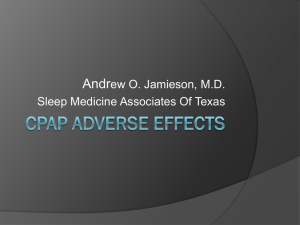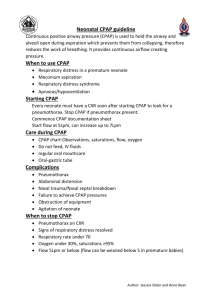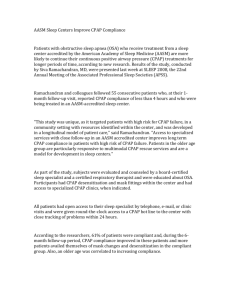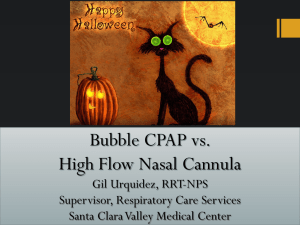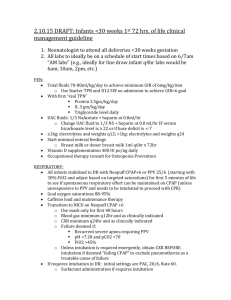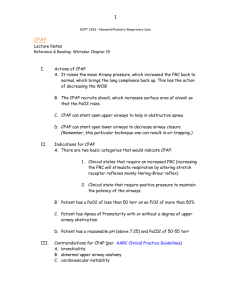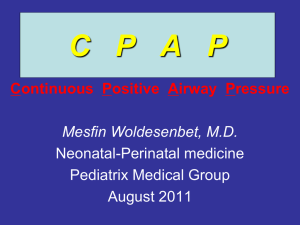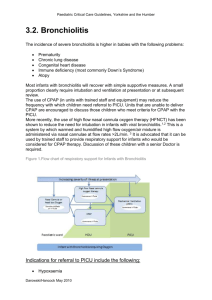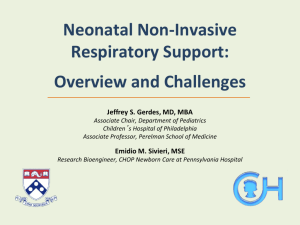CPAP-Adverse-Effects - Sleep Medicine Associates of Texas
advertisement
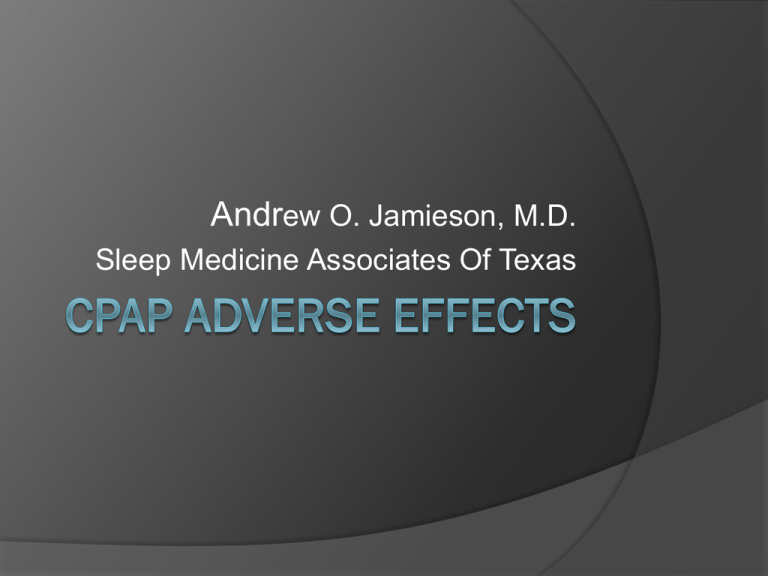
Andrew O. Jamieson, M.D. Sleep Medicine Associates Of Texas Presentation and references at www.sleepmed.com Like us at: /sleepmedtexas Talk objectives Understand the present status of adherence to CPAP therapy. Review adverse effects/side effects associated with CPAP. Discuss solutions, both general and specific. Outline Facts about CPAP compliance Facts about side effects General problems with CPAP Interface (mask) related problems Problems related to nasal route Pressure or airflow related problems Suggested solutions CPAP CPAP remains the predominant therapy for obstructive sleep apnea syndrome. It has been demonstrated to resolve sleepdisordered breathing events and several clinical outcomes. CPAP Adherence-the status quo. Subjective adherence is 65-90% Kribbs et al. 1993 Most pts overestimate use. “Religious” users: 90%/ 6 hrs/night. “Back sliders”: less than 3.5 hrs/night. McArdle et al. 1999. Traditional definition of compliance- “4 hrs X 70% of nights” Kribbs et al 1993,Engleman et al 1994, Reeves-Hoche et al 1994. 40% use Compliance ≠ Success Barriers to CPAP Use FIRST- Acceptance/Adoption of CPAP (5-20% don’t) THEN- The actual difficulties involved with its use. Factors influencing pts’ decision and commitment to to use. 1.Disease and patient factors 2.Technological and side effect factors 3.Psychological and social factors Side effects and CPAP adherence-a complicated relationship Approx. 2/3 of CPAP users experience side effects (Engleman, Wilde. 2003.) Poor mask fit Improper pressure levels Inadequate bedside coaching General Problems with CPAP Social unacceptability Interference with intimacy Claustrophobia Delayed sleep onset Inconvenient for travel Restriction of sleep position Interferes with TV or reading Agitated pets Triggers mood disorders Mask (interface) related problems Skin abrasion or rash Contact dermatitis facial and/or scalp (neoprene, rarely silicone} Bruising Sores Keratitis from air leaks Nasal folliculitis (nasal pillows) Water in the nose Mask (Interface) related (cont) Maxillary arch tenderness. Teeth movement in the maxillary arch, (diastoma) Mask anxiety (COPD pts) TMJ discomfort related to chin strap use Earache secondary to TM dysfunction TMD-pain, joint clicking, crepitus Bruxisim/clenching-related to need to prevent mouth vents. Hose entanglement. Noise Problems related to the nasal route Rhinorrhea, sneezing Nasal congestion Nasal/oral drying Epistaxis (may be massive) Insufflation of tear ducts Insufflation of middle ear TM rupture Increased intraocular pressure Pressure/airflow related Chest discomfort Suffocating sensation Arousals due to mouth venting Excessive cooling Aerophagia Sinus discomfort Difficulty exhaling (stacking breaths) Flatulence Pressure/airflow related (cont) Nausea Cardiac arrhythmia Pneumothorax (very rare) Pneumomediastinum (very rare) Edema (ANP suppression) Subcutaneous emphysema (very rare) Solutions Improving CPAP adherence. (Sawyer et al) 1. Treatment goals 2. Pt. education 3. Anticipatory guidance for common problems 4. Assisted initial exposure to CPAP 5. Include a support person 6. Interaction with other CPAP users 7. “Early and often” follow-up 8. Available resources for problem solving 9. Clinical follow up with the sleep team General Problems with CPAP Social unacceptability- Attitude Interference with intimacy-work around it. Claustrophobia-Desensitize Inconvenient for travel- Improving Restriction of sleep position- not necessary. Quick tubing disconnects Interferes with TV or reading- change interface Mask (interface) related problems. Comfort = Usage Skin abrasion or rash- Contact dermatitis? Skin oils? Headgear change, cotton padding Sores- Loosen, padding. Keratitis from air leaks- interface change Nasal folliculitis (nasal pillows)-change to OTN; topical abx. Cleaning regimen Water in the nose – humidity control Fit mask while lying down with pressure ON. For nasal/oral masks fit with jaw relaxed. Mask (interface) related (cont) Maxillary arch tenderness- Tension; interface change.. Mask anxiety (COPD pts)-desens. ?anxiolytics. VC breaths TMD-pain, joint clicking, crepitus- related to bruxism and tongue thrust (chin strap) Hose entanglement- positioning, suspension systems Noise- blowing/hissing mask adjustment Problems related to the nasal route Rhinorrhea, sneezing- Can do Afrin/steroid combo in selected pts Nasal congestion Nasal/oral drying- Pillows vs. Mask; adjust humidity Nosebleeds The only nasal response to cooling, drying, allergic challenge or mechanical irritation: BLOOD FLUX Laminar vs. Turbulent Flow Pressure/airflow related Chest discomfort-usually self limited; pressure adjustment Suffocating sensation- VC breaths; pressure relief Arousals due to mouth venting- (chin straps)- full face mask, increase humidity? Excessive cooling- adjustment Aerophagia – pressure adjustment; pressure relief Difficulty exhaling (stacking breaths) VC breaths, pressure relief Flatulence Use it, clean it. Persevere.
